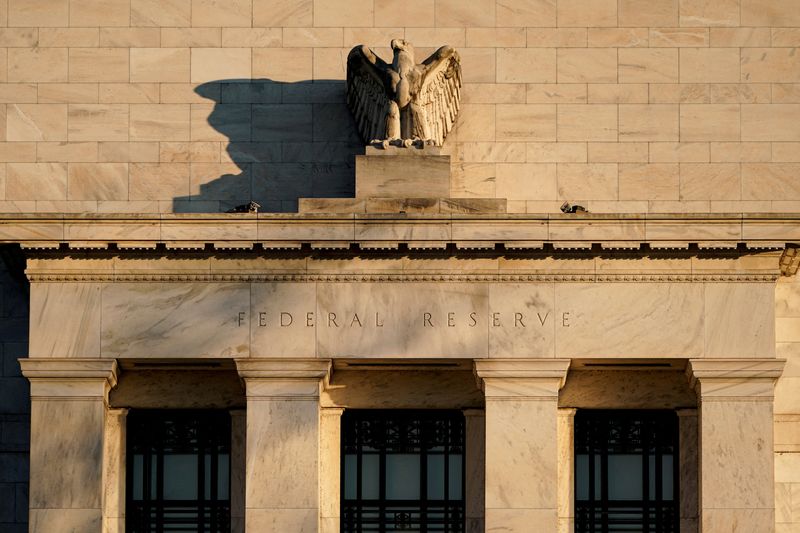By Howard Schneider
WASHINGTON (Reuters) - The Federal Reserve plans to raise interest rates in March on the assumption the U.S. economy will largely steer clear of fallout from the Omicron variant of the coronavirus and keep growing at a healthy clip.
What if it doesn't?
With financial markets fast adapting to expectations of an ever-more aggressive Fed battle against inflation, year-end data showed weaker-than-anticipated results for some of the inflation measures the U.S. central bank watches closely, a reminder of how uncertain its ultimate policy path remains.
The numbers were still high, with the employment cost index, the broadest measure of labor costs, rising 4% on a year-on-year basis in the fourth quarter, the largest increase since 2001, and the personal consumption expenditures price index jumping 5.8% on a year-on-year basis in December, the biggest annual rise since 1982 and nearly triple the Fed's 2% inflation target.
But the pace of change from the previous periods fell, and even as investors and many analysts continued penciling in more and faster Fed rate increases this year, some added a footnote.
The slowdown in employment cost growth, for example, was a "big step in the right direction" for Fed officials who expect price trends to ease on their own, said Ian Shepherdson, chief economist at Pantheon Macroeconomics.
Where Fed Chair Jerome Powell and other U.S. central bank officials have emphasized the risk that inflation may prove higher and require them to raise borrowing costs faster then expected, Shepherdson in recent forecasts sketched an opposing view: Of an economy that flatlines because of the coronavirus pandemic in the first three months of 2022, loses jobs in January and February, and produces inflation that is "falling sharply" by the second quarter, just as the Fed is presumably gearing up for its rate increases.
That scenario, out of step with investors who expect five rate hikes this year and some forecasters who have gone as high as seven, shows the degree of uncertainty still in play around where the economy is heading and how the Fed will respond.
'NO ROAD MAP'
An interest rate hike at the Fed's March 15-16 policy meeting is virtually assured at this point. But even the size of that increase is up in the air as some analysts expect the Fed, rather than the usual quarter-percentage-point rate hike, to opt for a larger half-percentage-point rise to tighten credit faster and demonstrate its seriousness in lowering inflation.
Much, however, rides on how the economy, inflation, financial markets and the virus behave in coming weeks.
Major U.S. stock indexes were trading higher on Friday, punctuating a week of heavy losses. Earlier in the day, the U.S. Commerce Department reported that consumer spending fell in December, weakness that may have continued into January given the massive outbreak of new coronavirus cases.
Consumer sentiment continued to decline at the start of the year, hitting the lowest point in a decade, according to the University of Michigan's closely watched gauge of American households' sentiment. Survey director Richard Curtin said the combination of Omicron, high inflation, and the steady dose of news about future Fed rate hikes could trigger a consumer backlash - a possible blow to economic growth on top of what's already coming through lowered government spending.
"The danger is that consumers may overreact to these tiny nudges," Curtin said.
That could help with inflation, at least some of which has been driven by strong demand for goods during the pandemic, but the Fed may be treading a fine line between what's needed to temper prices and what would be an overreach.
"Panic within the Fed's ranks has begun to set in. The challenge now is to tamp down inflation without allowing the flame on the overall economy to go out," wrote Diane Swonk, chief economist at Grant Thornton, a professional services firm. "There is no road map for doing this after inflation has surged."
Bond markets on Friday were showing some signs of caution. U.S. Treasury yields fell, and the gap between longer-term and shorter-term securities has narrowed - often taken as a loss of faith in future economic growth, falling inflation, or both.

Either way, said Minneapolis Fed President Neel Kashkari, it's a reason the U.S. central bank may not ultimately need to "slam on the brakes" with aggressive rate increases.
Despite the seemingly hawkish positioning of the Fed, Kashkari told NPR on Friday that the aim is not to restrict the recovery but "let our foot off the accelerator just a little bit."